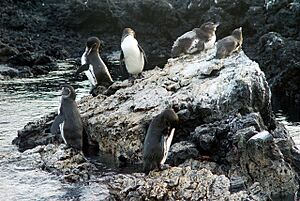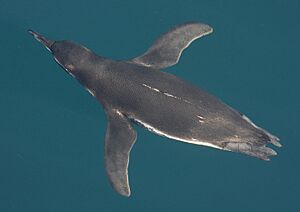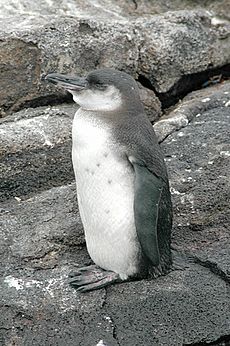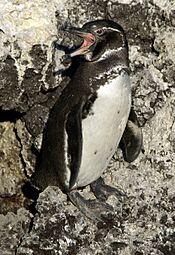Galapagos penguin facts for kids
Quick facts for kids Galápagos penguinTemporal range: Pleistocene to recent
|
|
|---|---|
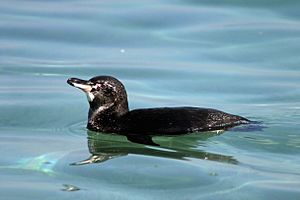 |
|
| Male swimming on Isabela Islands off Moreno Point, Galápagos Islands | |
| Conservation status | |
| Scientific classification | |
| Genus: |
Spheniscus
|
| Species: |
mendiculus
|
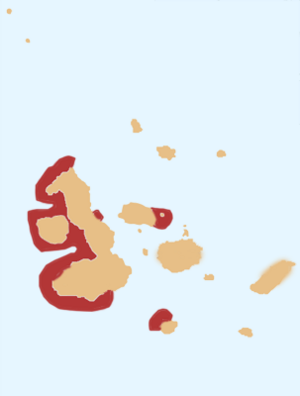 |
|
| Distribution of the Galápagos penguin | |
The Galápagos penguin (Spheniscus mendiculus) is a special type of penguin that lives only on the Galápagos Islands in Ecuador. It is the only penguin species found north of the equator, which is an imaginary line around the middle of the Earth. Most of these penguins live on Fernandina Island and the west coast of Isabela Island.
Even though they live in a warm, tropical area, cool ocean currents like the Humboldt and Cromwell Currents help them stay cool. The Galápagos penguin is one of the "banded penguins," a group that mostly lives near Africa and mainland South America. To deal with the heat, Galápagos penguins have learned special ways to keep cool. Their backs, flippers, and heads are black, while their bellies are white. They also have a white stripe that goes from their eyes down to their neck and chin. These penguins usually stay with one mate for life and can breed all year round. They often make their nests in caves or rocky cracks, which protects them from predators and the sun. Galápagos penguins can live up to 20 years, but many don't live that long in the wild because of predators. Sadly, their numbers have dropped a lot due to climate change and pollution from plastic waste.
Contents
Meet the Galápagos Penguin
The average Galápagos penguin is about 48 to 50 centimeters (19 to 20 inches) tall. They weigh around 2 to 4 kilograms (4.4 to 8.8 pounds). This makes them the second-smallest penguin species, right after the little penguin. Female penguins are usually smaller than males.
Galápagos penguins have black heads with a white border. This border starts behind their eye and goes around their ear area and chin, joining together on their throat. The top part of their beaks is black, fading to pink underneath. They have two black bands across their chest that connect to their back. The lower band goes down their sides to their thighs. Young penguins look a bit different. Their heads are completely dark, grayer on the sides and chin, and they don't have the chest bands yet.
Where Do Galápagos Penguins Live?
About 90% of Galápagos penguins live on Fernandina Island and the west coast of Isabela Island. These islands are in the western part of the Galápagos group. However, smaller groups of penguins also live on Santiago, Bartolomé, northern Santa Cruz, and Floreana. The northern tip of Isabela Island crosses the equator. This means some Galápagos penguins are the only penguins in the world that live in the Northern Hemisphere.
Galápagos Penguin Behavior
Galápagos penguins spend their days looking for food in the cool Cromwell Current waters. At night, they return to land. They mostly eat small fish that swim in groups, like mullet, sardines, and anchovies. Sometimes, they also eat small crustaceans. By eating these marine animals, they help control their populations. Adult Galápagos penguins can also become food for other animals, like sharks and whales. They usually stay close to their nesting spots, only traveling a few kilometers. They rely on the cold, nutrient-rich currents to bring them food.
The air temperature in the Galápagos is usually between 15 and 28 degrees Celsius (59 and 82 degrees Fahrenheit). During El Niño seasons, the penguins often wait to breed. This is because there isn't as much food available, making it hard to raise their young successfully. A very strong El Niño in 1982-83 caused their population to drop by 77%. Penguins usually breed when the sea surface temperature is below 25 degrees Celsius (77 degrees Fahrenheit).
The strong tropical sun is a big problem for these penguins. Their main way to cool down is to go into the water. But when they have to stay on land, they have other tricks. One way is to stretch out their flippers and hunch forward. This keeps the sun off their feet, which have a lot of blood flow and no insulation, so they can quickly release heat. Another way is to pant, which cools their throat and airways as water evaporates. Galápagos penguins protect their eggs and chicks from the hot sun by keeping them in deep cracks in the rocks.
The penguins' flipper-like wings and smooth bodies help them move easily in the water. Their black and white colors also help them control their body temperature and hide from predators. All these features help them survive in their coastal home. The penguins' breeding habits depend on finding good nesting spots in the volcanic landscape. They find shelter in cool, dark lava caves. These caves are perfect for raising their young because they offer protection from the sun. This shows how well these penguins have adapted to their unique environment.
Reproduction and Life Cycle
Galápagos penguins are monogamous, meaning each pair mates for life. There are about 1,000 breeding pairs of Galápagos penguins in the world. Their breeding depends on the climate. During El Niño, they might not breed because of the harsh conditions. After a courtship that includes bill "dueling," flipper patting, and preening each other, the pair will build a nest. Most nests are built between May and July, when food and climate conditions are usually best. Nests are made within 50 meters (164 feet) of the water on the shore. Adult penguins stay near their breeding area all year with their mate.
A female penguin lays one or two eggs in places like caves and cracks. These spots protect the eggs from direct sunlight, which could make them too hot. The temperature of the surface water also affects reproduction. They prefer temperatures between 17 and 22 degrees Celsius (63 and 72 degrees Fahrenheit) for incubating their eggs. If the temperature goes above 25 degrees Celsius (77 degrees Fahrenheit), their nests often fail. Both parents take turns incubating the eggs, which takes 38 to 40 days.
One parent always stays with the eggs or young chicks. The other parent might leave for several days to find food. A pair usually raises only one chick. Galápagos penguins will molt (shed their old feathers) before they breed. They are the only penguins that do this twice a year. Molting takes up to 15 days. They do this for safety, as food in the Galápagos can be hard to predict. If there isn't enough food, they might leave their nest.
It takes about 60 to 65 days for the chicks to become independent. Newly hatched chicks have soft, downy feathers. These feathers don't become waterproof until the chicks grow into juveniles. The juvenile feathers, which appear about 30 days after hatching, are dark brown or gray on top and white underneath. These feathers are mainly needed to protect the chicks from the strong sun, rather than to keep them warm.
A naturalist named Louis L. Mowbray was the first person to successfully breed Galápagos penguins in captivity.
Population Numbers
Galápagos penguins can live for 15 to 20 years. However, environmental factors and predators often shorten their lives. They are listed as an Endangered species on the IUCN Red List of Threatened Species. From 1993 to 2003, their average population was about 1,500 penguins. In 2003, there were an estimated 1,351 penguins, and by 2018, only about 1,200 adult penguins were left. The Galápagos penguin is now one of the rarest penguin species, similar to the yellow-eyed penguin.
The population size changes each year, depending on climate events. For example, after a La Niña event, when sea temperatures are cooler, both the population size and reproduction rates increase. However, El Niño events, which bring warmer waters, can reduce Galápagos penguin populations by almost 50%. This happens because warmer water disrupts the cold water that brings nutrients, which then affects the entire marine food chain.
Protecting Galápagos Penguins
Climate Change and El Niño
The Galápagos penguin is very vulnerable because it lives in such a small area on the Galápagos Islands. With only about 1,200 to 1,800 adult penguins, their population changes a lot due to human-caused changes in the region. The biggest danger to the Galápagos penguin is a climate event called El Niño. Strong El Niño events in 1982-83 and 1997-98 caused the penguin population to drop by 77% and 65% respectively. Weaker El Niño events also slowed down their recovery.
On the other hand, during La Niña events, when sea surface temperatures are cooler, Galápagos penguin populations start to recover. Climate change caused by humans is making El Niño events happen more often and become stronger. This is very bad for the Galápagos penguin. Warmer temperatures during El Niño mean female penguins are less healthy and adult penguins weigh less. This leads to less successful breeding and more female deaths, which hurts the population's ability to recover.
This lack of food during El Niño means penguins can starve. This happens because warmer temperatures reduce the "upwelling" of cold, nutrient-rich waters. This affects tiny ocean plants (phytoplankton), which are the base of the food chain, leading to less food for the penguins. Scientists predict that future El Niño events will become more frequent and severe. If the pattern of El Niño events from 1965 to 2004 continues, there's a 30% chance the Galápagos penguin could become extinct. If strong El Niño events double in frequency, the chance of extinction would be 80%.
Impacts from Human Activity
Even though the Galápagos Islands are far away, human activities around the world still affect the penguins. This connection comes from how human actions contribute to global environmental changes, especially climate change.
One major issue is pollution from human waste. When plastic, chemicals, and other trash are thrown into the ocean, they harm marine life and food chains. Penguins can get sick from eating prey that has absorbed these pollutants. The beautiful waters around the Galápagos Islands, known for their amazing wildlife, can become polluted by waste from cities, harming the penguins and their home.
Also, burning fossil fuels and industrial activities in cities release greenhouse gases. These gases cause climate change, which greatly affects Galápagos penguins. Rising temperatures and changing weather patterns can reduce the amount of food available for them. Since these penguins need a stable environment to survive, any changes caused by human-driven climate change can have serious effects on their numbers.
Illnesses
Illnesses are another possible threat to the Galápagos penguin. Early studies in 2001 didn't find signs of certain bird diseases like Avian malaria in Galápagos penguins. However, researchers still suggested more observation. This was because 800 chickens on the islands had died from a disease, and mosquitoes that carry Avian malaria were present.
Later, a 2009 study found a type of blood parasite in Galápagos penguins. This parasite causes Avian malaria. Finding this parasite suggests that diseases can travel from other bird populations to the isolated Galápagos penguins. This is likely a reason for their population decline. Understanding how these diseases reach the Galápagos Islands and spread among birds is important for protecting endangered species like the Galápagos penguin.
Other Threats and Conservation Efforts
Galápagos penguins face many threats to their survival. Besides climate change, other dangers include:
- Humans hunting penguins for oil and other products in the past.
- Competition with fishing boats for krill and other fish.
- Loss of their natural home.
- More predators from invasive species introduced by humans.
- Being accidentally caught in fishing nets (bycatch).
- Pollution.
On Isabela Island, introduced animals like cats, dogs, and rats can attack penguins, destroy nests, and spread diseases. Other natural predators on land include crabs, snakes, rice rats, Galápagos hawks, and short-eared owls. In the water, predators include sharks, fur seals, and sea lions. They also face problems with unreliable food and volcanic activity. Illegal fishing can disturb their nesting, and penguins are often caught in fishing nets by accident.
The Galápagos penguin population has low genetic diversity. This means they are more vulnerable to diseases, predators, and other environmental changes.
Galápagos penguins are protected under the Antarctic Treaty of 1959, which covers all 18 penguin species. Since they live in the Galápagos Islands, they are also protected by Ecuador's laws. The Directorate of the Galápagos National Park and the Galápagos Marine Reserve are important groups that protect the islands' species, including the Galápagos penguins. They do this by limiting human activity and preventing outside problems like fishing and introducing new species.
Tourism and Penguins
Tourism is very popular in the Galápagos Islands, bringing in millions of dollars each year. Since Galápagos penguins are unique to these islands, watching birds and nature tours that focus on penguins are common. You can even find guides on how to spot them.
As nature tourism grows, it has a bigger impact on local wildlife, including the Galápagos penguins. If tourism is not managed well, it can cause penguins to fail at reproducing, their burrows to collapse, or even lead to their death.
Galápagos Penguin Habitat
The Galápagos penguin is special because it lives only in the Galápagos Islands, mostly on Fernandina Island and Isabela Island. These islands provide the perfect environment for these birds to survive and thrive.
Living with Their Environment
Galápagos penguins have a special relationship with their home. Fernandina and Isabela Islands have rocky coastlines that are great for nesting. The waters around them, made rich by the Cromwell Current, are full of fish and crustaceans that the penguins eat. This feeding habit is very important for the local ocean ecosystem. They help keep the marine food web balanced and help with nutrient cycling. The guano (poop) from these penguins is a rich fertilizer, which helps the coastal soil and supports certain native plants.
How They Adapt to Island Life
These penguins have developed unique behaviors and body features to live in the warm, equatorial climate of the Galápagos. Unlike penguins in colder places, they have learned to handle warmer temperatures. They pant and look for shade during the hottest parts of the day to control their body heat. They also have less body fat and are smaller, which helps them release heat.
Galápagos penguins breed all year round. This allows them to take advantage of when food is most available, which changes with ocean currents. Being flexible with their breeding is a very important adaptation for surviving in an environment where food isn't always easy to find.
How Environment Affects Their Lives
Environmental conditions greatly affect how long Galápagos penguins live and how many there are. Climate events like El Niño greatly impact the ocean ecosystem, reducing the amount of food available. During such events, penguin populations face starvation, less successful breeding, and more deaths. Also, human-caused problems like pollution, oil spills, and fishing activities add more threats to their survival.
Efforts to protect these penguins are very important. They are listed as endangered by the IUCN Red List. Protection includes watching their population numbers, preserving their habitat, and reducing human impacts. These efforts are key to making sure the Galápagos penguin survives. They are a vital part of the amazing variety of life and natural balance of the Galápagos Islands.
Images for kids
See also
 In Spanish: Pingüino de las Galápagos para niños
In Spanish: Pingüino de las Galápagos para niños



